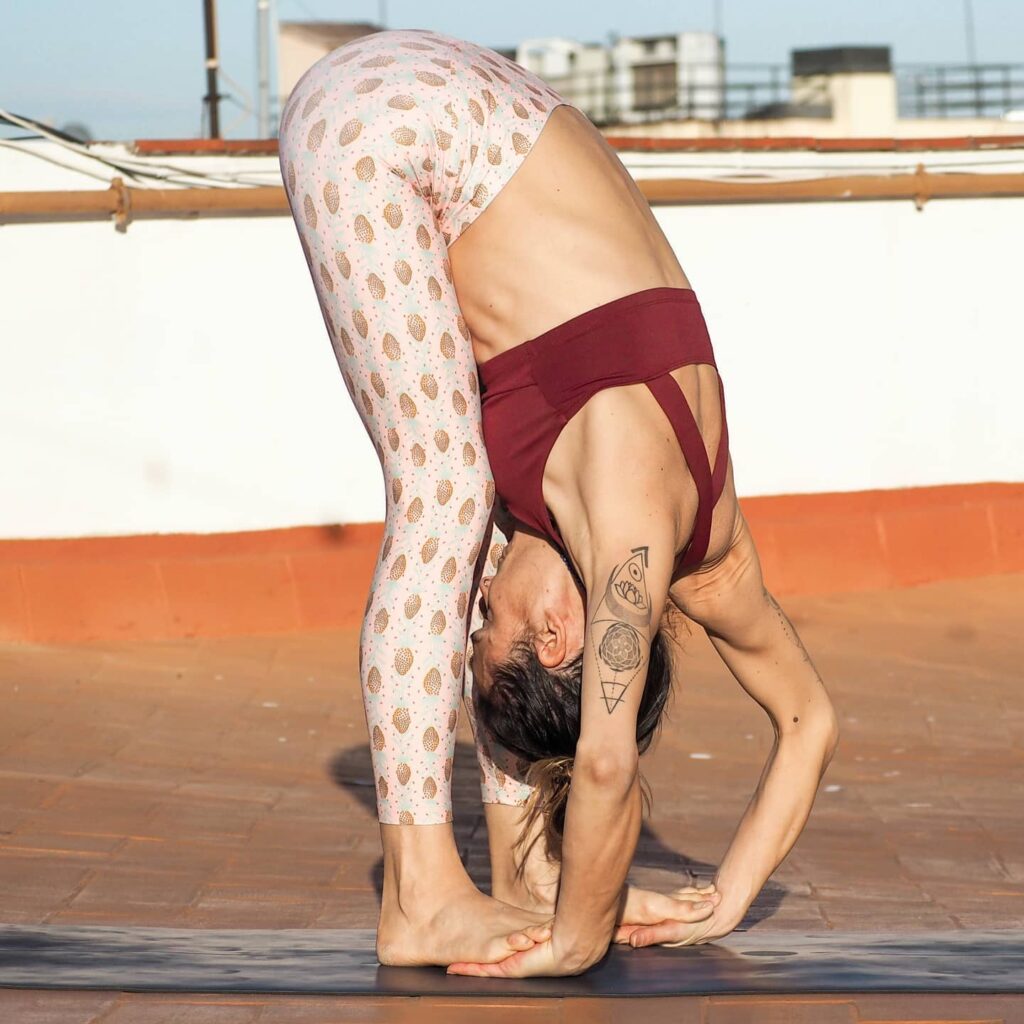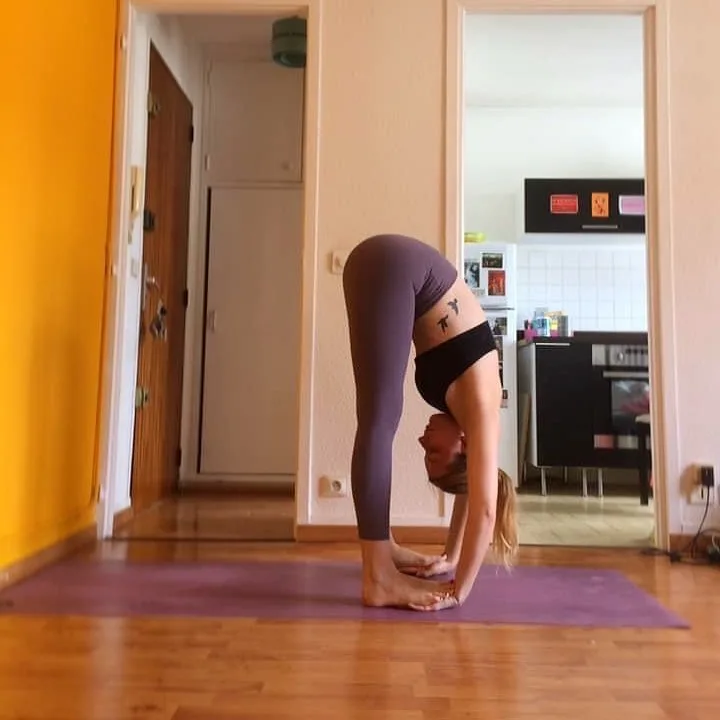Padahastasana, also known as Gorilla Pose, is a stretching pose that massages and tones your digestive organs while stretching and strengthening the thighs and hamstrings.
Expert believes that regular practicing Padahastasana release excess vata (air) from the stomach and improve blood circulation. The Gorilla Pose helps to eliminate excess belly fat, improves digestion, reduces constipation, and It eliminates many stomach ailments.
Information
| Known as: | Padahastasana, Gorilla Pose, Hands to Feet Pose, Standing Forward Bend Hands Under Feet Pose, Uttanasana Variation Hands Under Feet Pose |
| Sanskrit name: | पादहस्तासन |
| IAST: | Pādahastāsana |
| Pronunciation: | PAHD-ah-hahs-TAHS-ah-nah |
| Level: | Intermediate |
| Type: | Standing, forward bend |
| Focus: | Hamstrings, calves, thighs, wrist, entire back body |
| Total time: | 30 to 60 seconds plus |
| Drishti: | Forward; At shins; Closed |
| Chakra: | Ajna Chakra, Svadisthana Chakra, Muladhara Chakra |
| Indications: | Stress, anxiety, headaches, insomnia, menopause, digestion, liver, kidneys, flatulence, constipation, indigestion, spinal nerves, metabolism, concentration, nasal, throat diseases |
| Counterposes: | Mountain pose (Tadasana), Child’s Pose (Balasana), Chair Pose (Utkatasana), Cow Pose (Bitilasan) |
| Preparatory poses: | Downward-facing Dog Pose (Adho Mukha Shvanasana), Upward Half Forward Fold Pose (Ardha Uttanasana), Head-to-knee Pose (Janu Sirsasana), Seated Forward Bend Pose (Pashchimottanasana), Reclined Hand to Toe Pose (Supta Padangusthasana), Intense Forward-bending Pose (Uttanasana) |
| Follow-up poses: | Upavistha konasana (Wide-angle Seated Forward Bend Pose), Ardha Uttanasana (Standing Half Forward Bend Pose), Janu sirsasana (Head-to-knee Forward Bend Pose), Chaturanga Dandasana (Four-Limbed Staff Pose), Bhujangasana (Cobra Pose) |
| Contraindications: | Shoulders, neck, spine, hips, or knees Injuries, low blood pressure, back injury (keep the knees bent), pregnancy (careful modifications are possible; Widen stance and keep knees bent) |
Meaning + Origin
The Padahastasana is derived from the Sanskrit name, which is made up of three words — Pada + Hasta + Asana:
- “Pada” = “foot“
- “Hasta” = “hand“
- “Asana” = “pose or posture”
By bringing together the opposite and lower body, arms and legs, this yoga pose connects higher states of awareness and lower states of consciousness, bringing balance to body and mind. Similarly, the practice of Padahastasana connects the outer nature and the inner soul.
Benefits of Padahastasana (Gorilla Pose)
Since this variation is part of the Ashtanga series, the approach to practicing this pose should be more holistic. As Ashtanga Yoga talks on the practice of the 8 limbs of yoga, this variation of the further folds is said to bring about a connection between nature and the soul.
However, the physical and mental benefits of Padahastasana (Gorilla Pose) are listed below:
- Physical Benefits:
- Stretches the hips, hamstrings, wrists, entire back body, abdomen, and sciatic nerve
- Strengthens the back, spine, thighs, hamstrings, and upper body
- Encourages relaxation in shoulders and neck
- Balances the tamasic energy and vata dosha
- Improves the blood circulations
- Improves the range of motion of the neck and shoulders
- Awakens the nervous system
- Prevents the occurrence of carpal tunnel syndrome
- Helps to maintain the ideal weight, burns excess fat in the lower abdomen region
- Tones the para spinal, rectus abdominis muscles, and digestive organs
- Improves the flexibility of the hamstring muscles1
- Enhances circulation to the brain, pituitary, and thyroid glands
- Improves concentration and metabolism
- Decreases the nose and throat diseases
- Mental Benefits:
- Calms the mind
- Reduces stress
- Reduces the anxiety, insomnia, and nervousness
Padahastasana (Gorilla Pose) Practice Guide
Gorilla Pose (Hands to Feet Pose) should be practiced before or after backward bending poses such as:
- Cobra Pose (Bhujangasana)
- Wheel Pose (Chakrasana)
- Fish Pose (Matsyasana)
- Bridge Pose (Setu Bandha Sarvangasana)
During Padahastasana (Standing Forward Bend Hands Under Feet Pose), straps can be used for those who cannot easily reach their knees. Since belly fat is constantly burning, make sure you perform this yoga pose without any support. Some practitioners also bring their hands behind the shin. This allows you to pull yourself up, using the strength of the upper body to perform the pose effectively.
Step-by-step instructions to Padahastasana (Gorilla Pose)

- Begin in Mountain Pose (Tadasana), standing straight with a straight spine, feet together, heels and big toes slightly touching each other. Hands towards your body.
- Your body weight should be neither on your heels nor on your toes, but should be equally distributed on both of them. Relax and take deep breaths.
- Keep feet hip-width apart. While inhaling, slowly raise the hands upwards. Simultaneously, pull the body upwards.
- Exhale and slowly bend your trunk forward from the hips until the hands reach the feet.
- After this, place the palms of the hands under the soles.
- Keep your elbows slightly bent while pointing outwards.
- Loosen your shoulders and relax your arms. Take some slow breaths.
- Knees should be straight, your back should be concave, not bent.
- If possible, bring your forehead between your knees. Relax the back muscles of the neck.
- Take long and deep breaths, relax your body. Stay in this position for 30 to 60 seconds, or as long as you feel comfortable.
- Practice the pose 3 times more, gradually increasing the time day by day as your flexibility increases.
- To come out of the posture, take your hands out of your feet. Keeping your neck down, slowly straighten your body. After this also straighten your head. Take a few deep and slow breaths and practice again.
Tips
While leaning forward, move the torso by your hip joints, not by the waist. Keep your legs and knees straight throughout the exercise.
It may take a few days for the bottom of your feet to reach your hands. Stretch as comfortably as you can and stay there.
Common mistakes
Remember to listen to your body and respect your limits. Padahastasana can be a challenging pose, but with practice, you can enjoy its many benefits without causing harm.
Here are some common mistakes people make when practicing Padahastasana (Gorilla Pose) and how to avoid them:
- Rounding the spine: One of the most common mistakes is rounding the spine, which puts unnecessary pressure on the lower back and can cause injury. To avoid this, focus on keeping your spine long and extending forward from your hips, rather than rounding the back.
- Straining the neck: Another mistake is pulling the head forward and compressing the neck. Instead, keep the neck relaxed and let the head hang naturally.
- Locking the knees: Locking the knees in this pose can also cause injury. Keep a slight bend in your knees to prevent hyperextension and engage your quadriceps to support the knees.
- Overstretching the hamstrings: Overstretching the hamstrings can lead to injury and strain. Be mindful of your limits and avoid pushing beyond your range of motion.
- Tension in the shoulders: Tension in the shoulders can make it difficult to get into the pose and can also cause strain. Keep the shoulders relaxed and draw them away from the ears.
Precautions and contraindications
Precautions and contraindications to Uttanasana (Forward Fold Pose) as it is also a forward bend, with only the variation of the arm.
This intense stretching pose also cannot be practiced without much guidance and can damage some muscles if one does not understand the human anatomy.
You should be aware of the precautions and contraindications of Gorilla Pose (Standing Forward Bend Hands Under Feet Pose) while practicing.
Some precautions and contraindications to keep in mind while practicing this yoga pose are mentioned below:
- In this yoga posture, the weight of your entire body falls on the palms, wrists and fingers, so learning to maintain balance while keeping your body light is the trick of this Asana. Lack of balance or still learning to keep the body light during yoga practice should be taken care of while staying in this posture. Because this can cause injury to your fingers or loss of balance while pressing the feet firmly on the palms.
- The human body is so beautifully designed that it indicates that something is not right. Thus, in the pose if the body is communicating to you about a certain stretch, individuals should not ignore it at all.
- When there is pain in the lower back, this yoga pose should be avoided by deepening the stretch or by bending the knees. Any unwanted lower back strain while in the pose can only cause more damage to the hip joints or lower back muscles.
- This exercise should not be done if the person has a hamstring or knee injury.
- This intense forward stretch pose brings the lower back and sacrum to stretch deeply, and hence can be very harmful to the lower spine region if done without guidance.
- Gluteus extension can be painful if one has a weak hip bone, thus it is better to avoid it if one is not confident about the surrounding muscles’ hips and gluteus.
- A person suffering from migraine should avoid Standing Forward Bend Hands Under Feet Pose, as the sudden flow of fresh blood to the head in this Asana can create more tension, which can make the head heavy.
- Pressure in the abdominal area may not be good for a person with severe stomach ailments, as this pressure can irritate the stomach lining or the intestines more.
- Do not practice this pose if you have just had a meal, as the pressure towards the stomach can cause indigestion.
- A person with neck problems should avoid this yoga pose as the neck and head hang down, which can increase the tension.
- Any type of injury to the shoulder or upper back will bring more stress, so it is better to avoid it.
- If you have a back injury, avoid doing it with a full forward bend.
- Any type of severe joint pain can aggravate the condition if practiced without proper guidance, so it is advisable to avoid Hands to Feet Pose if the joints are not strong enough or there is a joint injury.
- Do not do this yoga Asana when you have sciatica.
- In case of high blood pressure, stay in the pose for extended periods only when the breath does not stretch.
- If you are pregnant or menstruating, avoid practicing this yoga pose completely by leaning forward. Instead, try a variation of this, i.e., Ardha Uttanasana, with the spine parallel to the floor and the hands on the wall.
- Volume-7. Issue-12. December-2018. PRINT ISSN No 2277 – 8179. INTERNATIONAL JOURNAL OF SCIENTIFIC RESEARCH. EFFECT OF PADAHASTASANA IN IMPROVING HAMSTRING MUSCLE FLEXIBILITY AMONG YOUNG ADULTS. Available here: https://www.worldwidejournals.com/international-journal-of-scientific-research-(IJSR)/fileview.php?val=December_2018_1543670627__01.pdf[↩]















